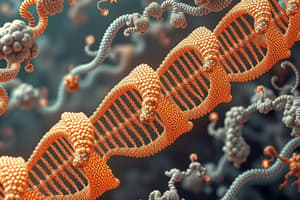Podcast
Questions and Answers
At the iso-electric point of a protein molecule, the net charge is:
At the iso-electric point of a protein molecule, the net charge is:
- Variable
- Positive
- Zero (correct)
- Negative
In acid solution, what charge does the basic group NH2 acquire?
In acid solution, what charge does the basic group NH2 acquire?
- -1
- 0
- +1 (correct)
- +2
Which type of colloids typically adsorb ions to acquire electric charges?
Which type of colloids typically adsorb ions to acquire electric charges?
- Hydrophobic colloids (correct)
- Hydrophilic colloids
- Lyophobic colloids
- Lyophilic colloids
Lyophilic colloids are thermodynamically:
Lyophilic colloids are thermodynamically:
Most lyophobic dispersions are _________ and have __________ hydration.
Most lyophobic dispersions are _________ and have __________ hydration.
Colloidal particles can acquire a positive or negative charge through:
Colloidal particles can acquire a positive or negative charge through:
Which method is most likely to be used for determining the molecular weight of polymers?
Which method is most likely to be used for determining the molecular weight of polymers?
Which of the following methods cannot cause sedimentation, even with the help of a laboratory centrifuge?
Which of the following methods cannot cause sedimentation, even with the help of a laboratory centrifuge?
In which colloidal dispersion are the particles negatively charged?
In which colloidal dispersion are the particles negatively charged?
Which factor mainly causes the particles in a colloidal dispersion to acquire charges?
Which factor mainly causes the particles in a colloidal dispersion to acquire charges?
Which of the following does not provide information regarding the shape of the particles in a colloidal dispersion?
Which of the following does not provide information regarding the shape of the particles in a colloidal dispersion?
What prevents the coagulation of particles with like charges on their surfaces?
What prevents the coagulation of particles with like charges on their surfaces?
Which colloidal dispersion has particles that may be positive, negative, or neutral depending upon the pH of the medium?
Which colloidal dispersion has particles that may be positive, negative, or neutral depending upon the pH of the medium?
What is the purpose of adding a hydrophilic colloid to a hydrophobic colloid?
What is the purpose of adding a hydrophilic colloid to a hydrophobic colloid?
What is the term for the weight of protective colloid needed to prevent a color change in gold sol?
What is the term for the weight of protective colloid needed to prevent a color change in gold sol?
What is the characteristic of surfactants that allows them to function as emulsifiers?
What is the characteristic of surfactants that allows them to function as emulsifiers?
What causes a reduction in zeta potential below the critical value, making a hydrophobic colloid sensitive?
What causes a reduction in zeta potential below the critical value, making a hydrophobic colloid sensitive?
What is the phenomenon where a hydrophilic colloid forms a protective cover on hydrophobic colloid particles, stabilizing the system?
What is the phenomenon where a hydrophilic colloid forms a protective cover on hydrophobic colloid particles, stabilizing the system?
Flashcards are hidden until you start studying




